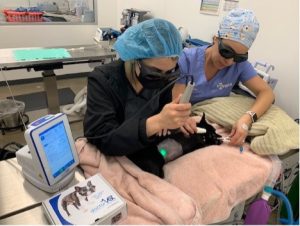
Therapeutic laser is the application of light energy to areas of the body to stimulate healing. West Coast Animal Hospital is pleased to offer this state-of-the-art service for wound-healing, surgical recovery, arthritis pain management, and orthopedic injury therapy. This light–tissue interaction is called photobiomodulation and is often referred to as “cold” laser (as opposed to a surgical or “hot” laser).
What types of conditions benefit from therapeutic laser?
The most common applications for therapeutic laser include muscular sprain/strain and the resultant pain, osteoarthritis (laser treatment over joints and muscles that are painful), post-operative application around incisions, wounds (to stimulate and accelerate healing) and any situation in which the pet is experiencing musculoskeletal pain.
How does therapeutic laser work?
Photobiomodulation (the laser–tissue interaction) creates many benefits within the body’s cells, with the most significant being reduction of pain and enhancement of healing by decreasing inflammation and tissue chemicals. Therapeutic laser also enhances healing by increasing microcirculation (blood flow through the smaller blood vessels of the body), stimulating cellular activity, and increasing growth factors.
How long does a therapeutic laser treatment last?
The length of a therapeutic laser treatment depends on the total dose of light energy to be delivered and how quickly the laser can deliver that energy. Depending on the size of the area being treated and number of sites, the procedure can take anywhere from 15-20 minutes.
How often will my pet need therapeutic laser, and how many treatments can I expect?
Most patients receiving therapeutic laser for arthritis or wounds are treated two to five times per week for several weeks. Acute issues are generally treated more frequently but over a shorter time frame, while chronic conditions tend to be treated less frequently but for a longer overall time frame.
Are there any reasons not to use therapeutic laser on a pet?
Therapeutic laser should not be used over areas of active bleeding or over the eyes, testicles, tumors, pregnancies, or growth plates in the bones.
